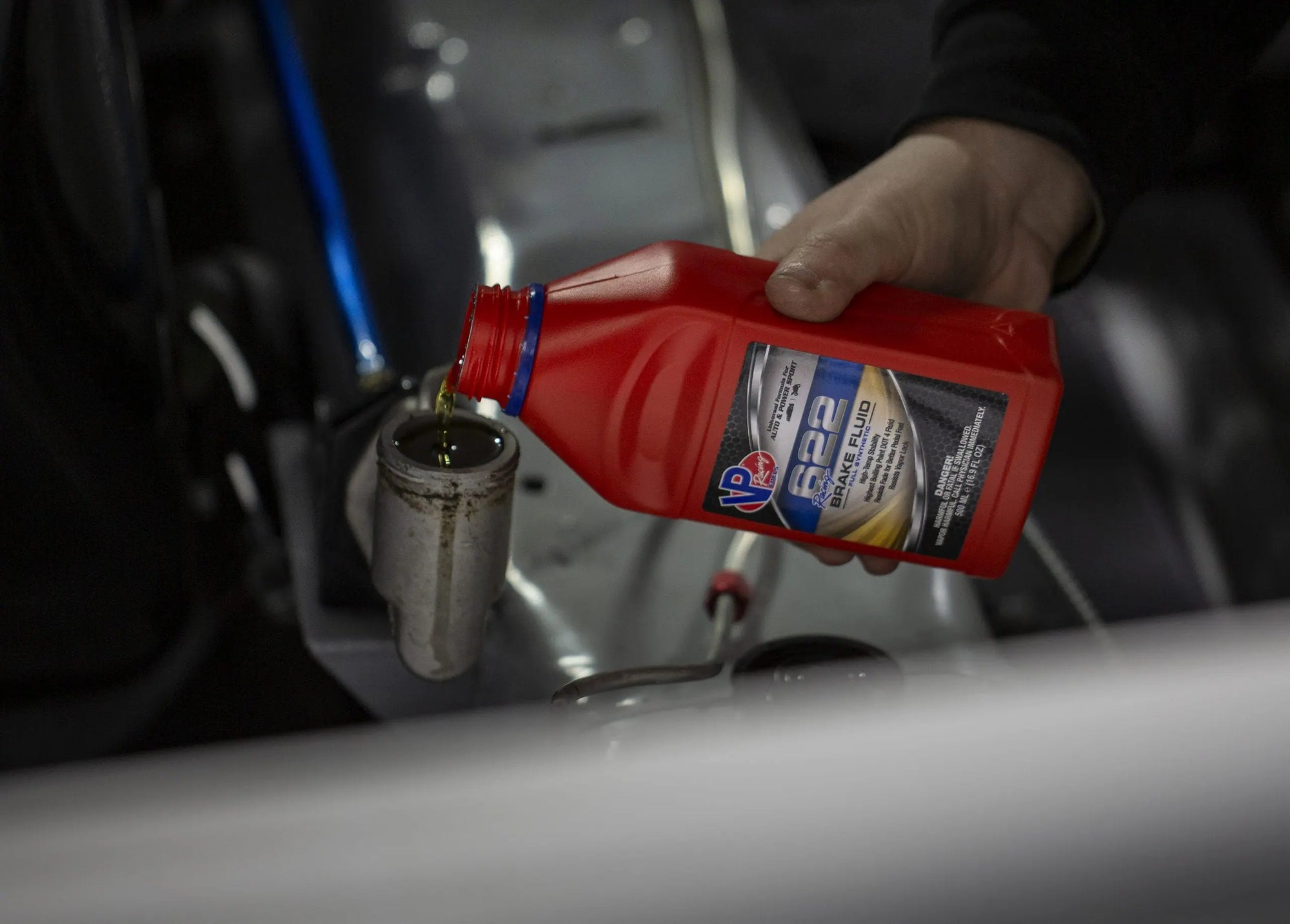What Type of Brake Fluid Do I Need? What Does It Do?
Estimated reading time 3:45
If you're DIY gearhead or weekend mechanic and getting ready to swap out your old brake fluid, you might wonder, "What type of brake fluid do I need?" After all, there are many types and brands on the market.
To better understand which brake fluid is right for you, let's first discuss what brake does (beyond the obvious of helping your brakes work properly). Brake fluid is a type of hydraulic fluid whose chief purpose is to convert brake pedal pressure into stopping power while remaining stable in various conditions. It has low compressibility and low and even viscosity.
Because it’s in contact with various metals, brake fluid is designed to be non-corrosive, non-conductive, and non-reactive. It also has a neutral pH. The fluid operates in extreme temperatures, so it’s made with a high boiling point, low freezing point, and is non-combustible. It also must have good lubricity.
Brake fluid is one of a braking system’s most overlooked performance parts. Whether you’re driving to work or enjoying a day on the track, the most important mechanical system in your car or powersport vehicle is arguably your brakes.
We mentioned boiling point a moment ago. What is that, and why is it important? When the brake calipers (and the fluid reaching them) get hot, the fluid will often boil. This produces gas, which is more compressible than the fluid. Thus, you're left with a soft, spongy brake pedal feel and a longer travel time when applying the brakes. It can be quite an unsettling feeling, not to mention unsafe.
Brake fluid is also hygroscopic. In other words, it absorbs moisture from the atmosphere, which takes place over time. Water can enter your system due to brake line leaks or broken seals in the master cylinder or caliper. When the fluid contains water, it starts to boil with less heat.
Because brake rotors and calipers generate excessive heat, the brake fluid must have a high heat tolerance. Otherwise, the fluid would vaporize inside your brake lines and create a dangerous situation because your brake system will not function properly.
Types of Brake Fluid:
When deciding on what type of brake fluid you need, you're faced with a couple of choices: Dot 3 vs. Dot 4 Brake Fluid (and don’t forget Dot 5). The characteristics of DOT 3 vs DOT 4 brake fluid differ, as does DOT 5.
The US Department of Transportation (DOT) established specifications defining several properties to which brake fluid must adhere. Those specifications relate to the fluid’s boiling point (both dry and wet), how viscous (flowable) the fluid is, and the stability of the fluid at high temperatures, among other properties.
The term “dry boiling point” refers to when the fluid is new (0% water), while “wet boiling point” refers to when the water content in the fluid reaches 3.7%.
DOT 3 brake fluid is the most common. It is primarily glycol ether. DOT 4 brake fluid is also glycol ether-based, but it has borate esters added to increase the boiling points. They manufacture DOT 5 brake fluid using silicone, which does not absorb water. The chart below illustrates the differences in wet and dry boiling points between DOT 3 vs. DOT 4 vs. DOT 5 brake fluid.
Fluid Classifications
| DOT Number | Dry Boiling Point | Wet Boiling Point |
| DOT 3 | 205o C / 401o F | 140o C / 284o F |
| DOT 4 | 230o C / 446o F | 155o C / 311o F |
| DOT 5 | 260o C / 500o F | 180o C / 356o F |
| DT 5.1 | 270o C / 518o F | 190o C / 374o F |
How Often Should I Change Brake Fluid? What if I Have a Track Car?
Maintaining your fluid via regularly scheduled service replacement intervals is important. Its performance will decline as the fluid ages. How often should you change your brake fluid and bleed the brakes depends on vehicle use and the type of brake fluid you use.
For a street car, where a balance of performance and affordability may be vital, consider bleeding your brakes and replacing the fluid once per year.
For a combination street and track car, the brake priorities change. Therefore, a racing brake fluid with low compressibility becomes essential to maintain a consistent pedal feel. A high dry boiling point is also crucial for performance under sustained track sessions. For track use, we recommended that you bleed the brake calipers each weekend and replace the fluid.
Okay, But What Kind of Brake Fluid Do I Need?
The type of brake fluid you need depends on the application. If you own a race car or high-performance vehicle, use a brake fluid with high lubricity, high dry boiling point (above 600o F), and low compressibility. This provides maximum stopping power and resistance to brake fade. If you own a racing or high-performance vehicle, you're in luck.
The experts at VP Racing design a premium 622 Full Synthetic Brake Fluid. It’s a high-performance, fully synthetic Dot 4 racing brake fluid. We formulate it for the demands of automobile and powersports racing. You can also use it in your daily driver or in extreme-performance vehicles.
VP 622 is a full synthetic formula. It affords multiple advantages and benefits:
- Maintains stability under high temperatures
- Resists vapor lock and fade
- Provides one of the highest wet boiling points of any DOT 4 fluid on the market
- Delivers a better pedal feel
A batch analysis showed VP 622 Racing Brake Fluid with a wet boiling point of 207° C (404° F)*.
*(Conformity Certificate No. C211222_82027_A043860-0001)
Check out what others are saying about 622 Brake Fluid:
- “Using this in our C8 Corvette for track days. Excellent wet and dry boiling points in a DOT 4 fluid.” – Submitted by James, Summit Racing online review
- “Superb Fluid – very high boiling point and never get vapor lock with this.” – Submitted by Lloyd, Summit Racing online review

